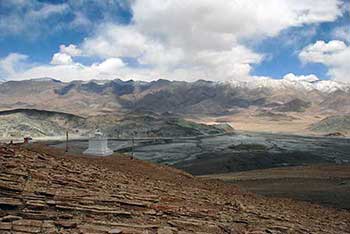
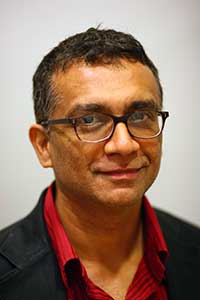 I work as a consulting editor for New Scientist in London. The city has been my home for the past six years. I moved here from Berkeley, California, to work in New Scientist's head office. It was when I became physics news editor (and subsequently deputy news editor) that the idea of The Edge of Physics began to take shape. I recount below the various trips that I made to research and write the book — a journey that began in October 2005 and ended four years later.
I work as a consulting editor for New Scientist in London. The city has been my home for the past six years. I moved here from Berkeley, California, to work in New Scientist's head office. It was when I became physics news editor (and subsequently deputy news editor) that the idea of The Edge of Physics began to take shape. I recount below the various trips that I made to research and write the book — a journey that began in October 2005 and ended four years later.
email: [email protected]
To contact me please email,
or leave a comment on the blog site
For publishing enquiries and questions
about book rights
please contact Peter Tallack at [email protected]
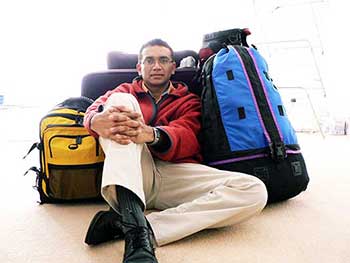 October 2005: All my bags are packed and I'm ready to go. Nervous hours before the first trip for the book — to the Atacama Desert in the Chilean Andes. Set for the flight to Madrid, and onwards to Santiago and Antofagasta, and the bus ride to Mount Paranal to see the European Southern Observatory's Very Large Telescope.
October 2005: All my bags are packed and I'm ready to go. Nervous hours before the first trip for the book — to the Atacama Desert in the Chilean Andes. Set for the flight to Madrid, and onwards to Santiago and Antofagasta, and the bus ride to Mount Paranal to see the European Southern Observatory's Very Large Telescope.
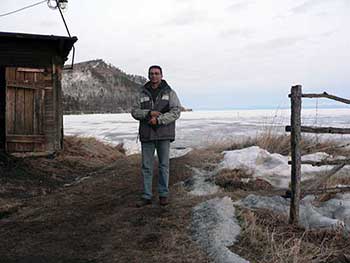 March 2006: Shivering on the shores of Lake Baikal, Siberia. A long journey that took me from London to Irkutsk via Moscow, a full eight time zones away, to see the Lake Baikal Neutrino Telescope. I had to go in winter because the scientific team works only in winter, for they need to use the lake's frozen surface as a platform to work on the telescope which is submerged in the deep waters of the world's biggest lake.
March 2006: Shivering on the shores of Lake Baikal, Siberia. A long journey that took me from London to Irkutsk via Moscow, a full eight time zones away, to see the Lake Baikal Neutrino Telescope. I had to go in winter because the scientific team works only in winter, for they need to use the lake's frozen surface as a platform to work on the telescope which is submerged in the deep waters of the world's biggest lake.
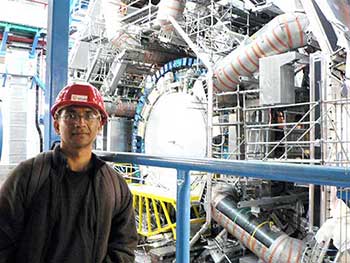 September 2006: Hundred metres underground, in front of the ATLAS detector of the Large Hadron Collider (LHC), which was still being assembled. Geneva is just a hop away from London, and the Swiss penchant for timely buses and trains meant that there was no drama as far as the travel was concerned. All the drama was 100 metres beneath the surface — inside the caverns and tunnels of the LHC and its detectors, such as ATLAS.
September 2006: Hundred metres underground, in front of the ATLAS detector of the Large Hadron Collider (LHC), which was still being assembled. Geneva is just a hop away from London, and the Swiss penchant for timely buses and trains meant that there was no drama as far as the travel was concerned. All the drama was 100 metres beneath the surface — inside the caverns and tunnels of the LHC and its detectors, such as ATLAS.
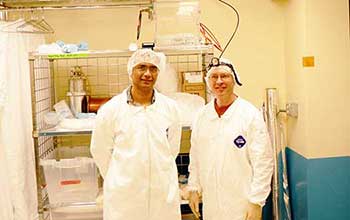 February 2007: In the ante-room outside the RF cage housing the Cryogenic Dark Matter Search experiment. You can't tell — but we are more than 700 metres below the surface, deep inside an abandoned mine in Soudan in Northern Minnesota. On the right is my host Michael Dragowsky, the shift leader of CDMS during my visit.
February 2007: In the ante-room outside the RF cage housing the Cryogenic Dark Matter Search experiment. You can't tell — but we are more than 700 metres below the surface, deep inside an abandoned mine in Soudan in Northern Minnesota. On the right is my host Michael Dragowsky, the shift leader of CDMS during my visit.
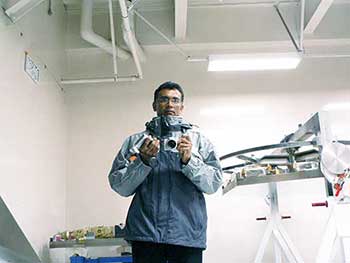 June 2007: Reflection in one hexagonal segment of the KECK's 10-metre segmented mirror, up on the summit of Mauna Kea, Hawaii (the segment, of course, was a spare). This was another long trip, from London to Denver to participate in a briefing for the upcoming trip to Antarctica, and then onward to Hawaii to see the KECK telescopes.
June 2007: Reflection in one hexagonal segment of the KECK's 10-metre segmented mirror, up on the summit of Mauna Kea, Hawaii (the segment, of course, was a spare). This was another long trip, from London to Denver to participate in a briefing for the upcoming trip to Antarctica, and then onward to Hawaii to see the KECK telescopes.
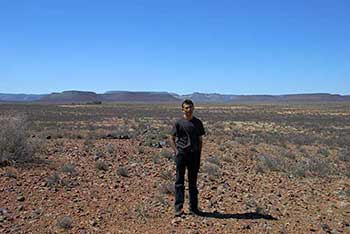 October 2007: How barren can land get? The potential site of the world's largest radio telescope: the Square Kilometre Array. This is the Karoo in South Africa, nearly 8 hours drive from Cape Town. The mesas behind form a formidable barrier to radio signals, protecting this site from the population centres of the south. To the north, there is nothing but emptiness, as the Karoo merges into the Kalahari Desert.
October 2007: How barren can land get? The potential site of the world's largest radio telescope: the Square Kilometre Array. This is the Karoo in South Africa, nearly 8 hours drive from Cape Town. The mesas behind form a formidable barrier to radio signals, protecting this site from the population centres of the south. To the north, there is nothing but emptiness, as the Karoo merges into the Kalahari Desert.
 December 2007: Finally, the final frontier: Antarctica — the Ross Ice Shelf near McMurdo. The Ross Ice Shelf is the staging ground (if 200-feet-thick ice can be called ground) for some of the most dramatic scientific balloon experiments. I witnessed the launch of BESS, the Balloon-borne Experiment with a Superconducting Spectrometer.
December 2007: Finally, the final frontier: Antarctica — the Ross Ice Shelf near McMurdo. The Ross Ice Shelf is the staging ground (if 200-feet-thick ice can be called ground) for some of the most dramatic scientific balloon experiments. I witnessed the launch of BESS, the Balloon-borne Experiment with a Superconducting Spectrometer.
 January 1, 2008: Well, actually, this was the final frontier: The South Pole. Behind is the 10-metre South Pole Telescope. But I was here to watch physicists and their drilling team who were building IceCube, the world's biggest neutrino telescope. It involes drilling 80 holes into the 3-kilometre-thick ice at the pole. Each hole is 2.5 kilometres deep.
January 1, 2008: Well, actually, this was the final frontier: The South Pole. Behind is the 10-metre South Pole Telescope. But I was here to watch physicists and their drilling team who were building IceCube, the world's biggest neutrino telescope. It involes drilling 80 holes into the 3-kilometre-thick ice at the pole. Each hole is 2.5 kilometres deep.
 February 2008: Inside the dome of one of the most precious telescopes in history: the 100-inch atop Mount Wilson in Southern California. Behind is the blue-coloured truss of the telescope tube. Edwin Hubble discovered the expansion of the universe with this telescope in the 1920s.
February 2008: Inside the dome of one of the most precious telescopes in history: the 100-inch atop Mount Wilson in Southern California. Behind is the blue-coloured truss of the telescope tube. Edwin Hubble discovered the expansion of the universe with this telescope in the 1920s.
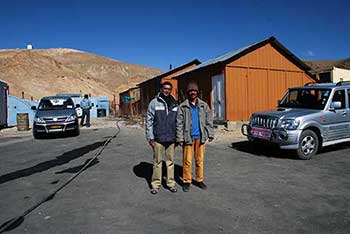 April-May 2008: On the Tibetan Plateau in the Indian Himalayas, at an altitude of 14,000 feet. Indian astronomer Tushar Prabhu on the right.Behind us rises Mount Saraswati, on which are being built the telescopes of the Hanle Observatory.
April-May 2008: On the Tibetan Plateau in the Indian Himalayas, at an altitude of 14,000 feet. Indian astronomer Tushar Prabhu on the right.Behind us rises Mount Saraswati, on which are being built the telescopes of the Hanle Observatory.
The staggering view from atop Mount Saraswati. My travels ended here.
